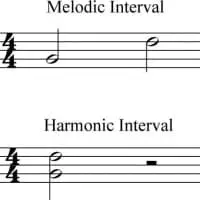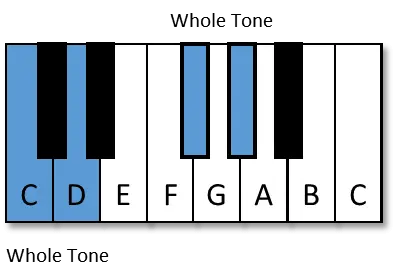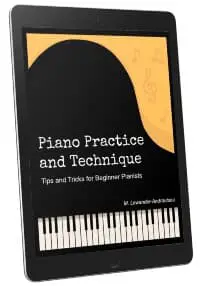- Home
- Basic Piano Theory
- Musical Intervals
Identifying Musical Intervals
This article may contain compensated links. Please read the disclosure for more info.
Learning musical intervals is easy if you know some simple tricks. Here you will learn how to identify and understand simple intervals. Learning to quickly identify intervals will help you when playing and reading music and when learning music theory.
Musical Intervals
What is an interval in music?
What is an interval in music?
Simply put, in music, an interval is the distance in steps from one note to the next.
Why do I need to know about intervals?
Why do I need to know about intervals?
Knowing about intervals and being able to identify intervals as patterns quickly helps both when playing and reading music.
Melodic and Harmonic Intervals

If we play intervals one note after the other; it is called a melodic interval (like a melody).
Or if the notes are played at the same time (creating harmony), it is called a harmonic interval.
Naming Musical Intervals

An Interval can be described in two ways:
- By Number
- And by Quality
Step one; you need to identify the number or how many steps there are from one note to the next (this is what we'll learn here).
Step two is to identify the quality. (This will be covered in the next lesson.)
Measuring the distance from one note to the next is very easy. Simply count!
This is a List of Basic Music Intervals
1. Unison
- From one note to another, if the notes are on the same note, it's called a Unison. (Yes, it's actually an interval too!)

2. Second
- Starting from any note, to the next note up or down, it's called a Second (2nd).

3. Third
- From any note, up or down, counting 1,2,3 (skipping one note in between) is a Third (3rd).

4. Fourth
- Skipping two notes in between (count 1,2,3,4), is a Fourth (4th).

5. Fifth
- Skipping three notes in between (count 1,2,3,4,5), is a Fifth (5th).

6. Sixth
- Skipping four notes in between (count 1,2,3,4,5,6), is a Sixth (6th).

7. Seventh
- Skipping five notes in between (count 1,2,3,4,5,6,7), is a Seventh (7th).

8. Octave
- Skipping six notes in between (count 1,2,3,4,5,6,7,8) is called an Octave. Why not call it an Eighth? Yes, you could, but it is more common to call it an Octave (Which is Latin for 8th).

Notice that when you have an Octave, the notes are the same; in this case a C and a C.
Simple Intervals & Compound Intervals
These intervals, reaching up to an octave, are called Simple Intervals because they are (duh) simple! :)
Larger intervals after the octave are logically called a ninth, tenth, eleventh, and so on. But we can also observe that the larger intervals repeat in the same order as above, just with the added octave.
So, a ninth is actually an octave plus a second. A tenth is an octave plus a third etc. These larger intervals (more than an octave) are called compound intervals.
How to Quickly Figure Out Musical Intervals
There is a little trick to learning how to quickly identify and remember musical intervals:
- First; after you know to count (as we did above) - stop counting!
- Instead, look at the "shape" of each interval.
One interval you can quickly learn without counting is the Unison since it is so easy to spot (two notes that are the same):

Now it gets interesting! Let's take a closer look at these specific intervals; 2nd, 4th, 6th, and Octave (2,4,6,8). Can you see what they have in common?:

Did you notice that one note in the interval is a line note, and the other is a space note? They have an "uneven" look. But the numbers? They are even! (2,4,6,8)
- So, the group of intervals with even numbers has an un-even look.
See, it's pretty easy to identify each interval without counting!
Now let's take a look at the other group. 3rd, 5th and 7th. (Above 3,5,7). (Yep, only three- since the Unison is too easy to learn, and we did that already.)
See how both notes are either space-space or line-line in each of these intervals?
- So, un-even numbers... have an even look!
Identifying Musical Intervals in 2 Steps
Now you see how easy it was to understand the basic, simple intervals.
- The first step in learning intervals was identifying the number as we did here, by counting, and visually.
- The next step is to learn how each interval can be either major, minor, perfect, augmented, or diminished. This is called Interval Quality. Ready to learn more?
Go to Music Interval Quality >>






